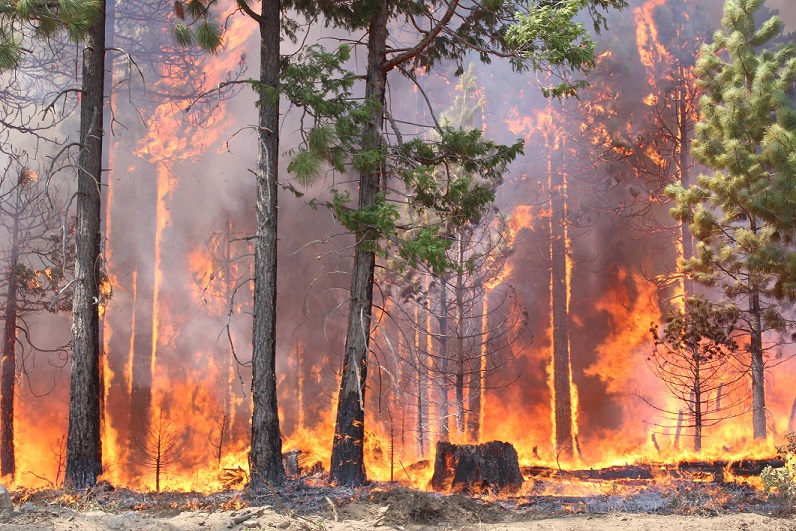
by Deep Green Resistance News Service | Sep 30, 2017 | Biodiversity & Habitat Destruction
Editor’s note: The following is the testimony of Dr. Dominick A. DellaSala, Chief Scientist of Geos Institute, Ashland, Oregon, before the U.S. House of Representatives Natural Resources Committee, Subcommittee on Oversight and Investigations, “Exploring Solutions to Reduce Risks of Catastrophic Wildfire and Improve Resilience of National Forests,” on September 27, 2017.
Chairman Westerman, Ranking member Hanabusa, and subcommittee members, thank you for the opportunity to discuss wildfires on national forests. I am the Chief Scientist of the nonprofit organization, Geos Institute in Ashland, Oregon. Geos Institute works with agencies, landowners, and decision makers in applying the best science to climate change planning and forest management. As a scientist, I have published in peer-reviewed journals on fire ecology and climate change, I am on the editorial board of several leading journals and encyclopedias, and I have been on the faculty of Oregon State University and Southern Oregon University. A recent book I co-authored with 28 other scientists outlined the ecological importance of mixed-severity fires in maintaining fire-resilient ecosystems, including ways to coexist with wildfire (DellaSala and Hanson 2015).
Wildfires are necessary natural disturbance processes that forests need to rejuvenate. Most wildfires in pine and mixed-conifer forests of the West burn in mixed fire intensities at the landscape scale that produce large and small patches of low to high tree mortality. This tapestry of burned patches is associated with extraordinary plant and wildlife diversity, including habitat for many big game and bird species that thrive in the newly established forests. From an ecosystem perspective, natural disturbances like wildfires are not an ecological catastrophe. However, given there are now 46 million homes in naturally fire-prone areas (Rasker 2015), and no end in sight for new development, we must find ways to coexist with natural disturbance processes as they are increasing in places due to climate change.
In my testimony today, I will discuss how proposals that call for increased logging and decreased environmental review in response to wildfires and insect outbreaks are not science driven, in many cases may make problems worse, and will not stem rising wildfire suppression costs. I will also discuss what we know about forest fires and beetle outbreaks in relation to climate change, limitations of thinning and other forms of logging in relation to wildfire and insect management, and I will conclude with recommendations for moving forward based on best available science.
I. WHAT WE KNOW ABOUT RECENT FOREST FIRE INCREASES
Recent increases in acres burned of forests are mainly due to a changing climate – Scientists have known for sometime that fire activity tracks regional weather patterns, which in turn, are governed by global climatic forces such as the Pacific Decadal Oscillation (PDO – a recurring long-lived El Niño-like pattern of Pacific climate variability– see chart 1). For instance, the very active fire seasons of the 1910-1930s, occurred during prolonged drought cycles determined by the PDO that resulted in much larger areas burning historically than today (Powell et al. 1994; Interagency Federal Wildland Fire Policy Review Working Group 2001; Egan 2010) (chart 1). In fact, compared to the historic warm PDO phase of the early 1900s, most of the West is actually experiencing a fire deficit (Littell et al. 2009, Parks et al. 2012). However, with warming temperatures, early spring snowmelt, and longer fire seasons over the past few decades more acres are burning each year (Westerling et al. 2006; Littell et al. 2009) (chart 1).
For instance, wildfire season in the West has lengthened from an average of five to seven months, and the number of large wildfires (>1,000 acres) has increased since the 1980s (Dennison et al. 2014) from 140 to 250 per year (UCS 2017). This is occurring as average annual temperature in the West has risen by nearly 2 degrees F since 1970s and winter snow pack has declined (UCS 2017). If measures are not taken to stem greenhouse gas emissions, wildfire acres are projected to increase further in dry areas as annual temperatures are expected to rise another 2.5 to 6.5 degrees F by mid century (UCS 2017). Some researchers estimate more than half of the increase in acres burned over the past several decades is related to climate change (Abatzoglou and Williams 2016). This increase is expected to continue with additional warming leading to even greater suppression costs if the agencies continue to suppress fires across the landscape (Schoennagel et al. 2017).
Increasing Human Development is Lengthening Wildfire Seasons and Adding to Fire Ignitions – The direct role of human-access via roads and development in the Wildlands Urban Interface (WUI) is increasing wildfire activity. Scientists recently evaluated over 1.5 million government records of wildfires nationwide from 1992 to 2012 (Balch et al. 2015). During that time, human-caused fire ignitions have vastly expanded the spatial and seasonal occurrence of fire, accounting for 84 percent of all wildfire starts and 44 percent of the total area burned nationally. We now have the phenomenon of a human-caused fire season, which was three times longer than the lightning-caused fire season and added an average of 40,000 wildfires per year across the US over this 20-year period of time. Ignitions caused by people – whether accidental or arson – have substantial economic costs. This will only worsen with continued development of the WUI adding to the 46 million homes (Rasker 2015) already in these fire-prone areas.
Thus, given expansion of homes in the WUI, the best way to limit damage to homes is to reduce fire risks by working from the home-outward instead of the wildlands-inward (Syphard et al. 2013). For instance, if a fire-brand travels miles ahead and lands on a flammable roof that home is very likely to burn compared to a home that has a fire resistant roof and cleared vegetation within a narrow defensible space of 100-200 feet immediately surrounding the home (Cohen 2000). Logging outside of this narrow zone does not change home ignition factors.
II. WHAT WE KNOW ABOUT FIRE AND FOREST MANAGEMENT
Wilderness and other protected areas are not especially prone to forest fires – proposals to remove environmental protections to increase logging for wildfire concerns based on the assumption that unmanaged – or protected areas – burn more intensely are misplaced. For instance, scientists (Bradley et al. 2016 of which I was a co-author) recently examined the intensity of 1,500 forest fires affecting over 23 million acres during the past four decades in 11 western states. We tested the common perception that forest fires burn hottest (most intensely) in wilderness and national parks while burning cooler (less intensely) or not at all in areas where logging had occurred. What we found was the opposite – fires burned most intense in previously logged areas, while they burned in natural fire mosaic patterns in wilderness, parks, and roadless areas, thereby, maintaining resilient forests (see chart 2). Consequently, there is no reason for reducing environmental protections.
State lands are not at lower wildfire risks compared to federal lands – there is much discussion about whether state lands are being managed in a way that reduces fire occurrence and intensity. However, in a recent report of wildfire risk (that included acres likely to burn), scientists (Zimmerman and Livesay 2017) used the West Wide Wildfire Risk Assessment model, an important assessment tool of the Council of Western State Foresters and Western Forestry Leadership Coalition. They evaluated risk for western states based on historical fire data, topography, vegetation, tree cover, climate, and other factors. According to the Center for Western Priorities analysis, state (22%) and federal (23%) lands have approximately equivalent levels of fire risks in the West, and for some states, risks were higher than federal lands. Notably, allegations of higher fire risk based solely on the number of federal acres burned in a fire season are misleading as there are over 7 times as many federal lands (362 million acres) in 11 Western states as compared to state-owned lands (49 million acres) (Zimmerman and Livesay 2017).
Thinning is Ineffective in Extreme Fire Weather – thinning/logging is most often proposed to reduce fire risk and lower fire intensity. Thinning-from-below of small diameter trees followed by prescribed fire in certain forest types can reduce fire severity (Brown et al. 2004, Kalies and Kent 2016) but only when there is not extreme fire weather (Moritz et al. 2014, Schoennagel et al. 2017). Fires occurring during extreme fire-weather (high winds, high temperatures, low humidity, low fuel moisture) will burn over large landscapes, regardless of thinning, and in some cases can burn hundreds or thousands of acres in just a few days (Stephens et al. 2015, Schoennagel et al. 2017). Fires driven by fire weather are unstoppable and are unsafe for fire fighters to attempt putting them out, and, as discussed, are more likely under a changing climate.
Further, there is a very low probability of a thinned site actually encountering a fire during the narrow window when tree density is lowest. For example, the probability of a fire hitting an area that has been thinned is about 3-8% on average, and thinning would need to be repeated every 10-15 years (depending on site productivity) to keep fuels at a minimum (Rhodes and Baker 2008).
Thinning too much of the overstory trees in a stand, especially removal of large fire-resistant trees, can increase the rate of fire spread by opening tree canopies and letting in more wind, can damage soils, introduce invasive species that increase flammable understory fuels, and impact wildlife habitat (Brown et al. 2004). Thinning also requires an extensive and expensive roads network that can degrade water quality by altering hydrological functions, including chronic sediment loads.
Post-disturbance salvage logging reduces forest resilience and can raise fire hazards –commonly practiced after natural disturbances like fires or insect outbreaks, post-disturbance logging hinders forest resilience by compacting soils, killing natural regeneration of conifer seedlings and shrubs associated with forest renewal, increasing fine fuels from slash left on the ground that aids the spread of fire, removing the most fire-resistant large live and dead trees, and degrading fish and wildlife habitat. Further roads that increase sediment flow to streams triggering widespread water quality problems (Lindenmayer et al. 2008).
III. WHAT WE KNOW ABOUT BEETLE-KILLED FORESTS AND FOREST MANAGEMENT
Beetle Killed Forests are Not More Susceptible to Forest Fires – forests in the West are being affected by the largest outbreaks of bark beetles in decades, which has caused concern about forest resilience and wildfire risk and led to proposals for widespread tree removals. Such proposals stem in part from the rationale that bark beetle outbreaks increase wildfire risks due to dead trees and that logging in beetle-affected forests would therefore lower such risks. However, beetle-killed forests are not more susceptible to forest fires (Bond et al. 2009, Hart et al. 2015, Meigs et al. 2016). This is mainly because when conifers die due to drought or native bark beetles, the combustible oils in the needles quickly begin to dissipate, needles and small twigs begin to fall to the ground. Without the fine fuels that facilitate fire spread, potential crown fires are actually lowered in forests with beetle mortality (Donato et al. 2013). The beetle-killed standing dead trees (snags) are the least flammable part of the forest and act more like a large log in a campfire, rather than kindling which is what causes fire spread.
In fact, studies of beetle-killed forests in the West found that when fires occurred during or immediately after the pulse of snag recruitment from beetle kill, fire severity consistently declined in the stands with high snag densities in the following decades (Meigs et al. 2016). In pine and mixed-conifer forests of the San Bernardino National Forest (CA), fires occurred immediately after a large pulse of snag recruitment from drought and beetles. However, scientists (Bond et al. 2009) found “no evidence that pre-fire tree mortality influenced fire severity.” In studies of beetles and wildfires across the western U.S., scientists (Hart et al. 2015) stated “contrary to the expectation of increased wildfire activity in recently infested red-stage stands, we found no difference between observed area and expected area burned in red-stage or subsequent gray-stage stands during three peak years of wildfire activity, which account for 46 percent of area burned during the 2002–2013 period.” And finally, in a comprehensive review of fire-beetle relations in mixed-conifer and ponderosa pine forests of the Pacific Northwest, scientists (Meigs et al. 2016) found: “in contrast to common assumptions of positive feedbacks, we find that insects generally reduce the severity of subsequent wildfires. Specific effects vary with insect type and timing, but insects decrease the abundance of live vegetation susceptible to wildfire at multiple time lags. By dampening subsequent burn severity, native insects could buffer rather than exacerbate fire regime changes expected due to land use and climate change.”
Most importantly, climate change is allowing more insects to survive the winter, triggering the rash of recent outbreaks (Meigs et al. 2016).
Thinning cannot limit or contain beetle outbreaks – once beetle populations reach widespread epidemic levels, thinning treatments aimed at stopping them do not reduce outbreak susceptibility as beetles over run natural forest defenses with or without thinning (Black et al. 2013).
IV. CLOSING REMARKS AND RECOMMENDATIONS
In sum,
Recent increases in wildfires and insect outbreaks are a result of a changing climate coupled with human-activities including expansion of homes and roads into the WUI that will only continue to drive up fire suppression costs.
Policies should be examined that discourage continued growth in the WUI; any new development must include defensible space and construction from non-flammable materials.
The most effective way to protect homes is to create defensible space in the immediate 100 feet of a structure and use of non-flammable materials. Wildland fire policy should fund defensible space, not more logging and thinning miles away from communities.
No amount of logging can stop insect outbreaks or large fires under extreme fire weather. Logging may, in fact, increase the amount of unnatural disturbances by homogenizing landscapes with more even aged trees, residual slash left on the ground, and compounding cumulative impacts to ecosystems.
Thinning of small trees in certain forest types, maintaining canopy closure and in combination with prescribed fire can reduce fire intensity but treatment efficacy is limited in extreme fire weather, and by the small chance that a thinned site will encounter a fire during a very narrow window when fuels are lowest.
CITATIONS
Balch, J. K., B.A. Bradley, J.T. Abatzoglou et al. 2016. Human-started wildfires expand the fire niche across the United States. PNAS 114: 2946-2951.
Black, S.H., D. Kulakowski, B.R. Noon, and D.A. DellaSala. 2013. Do bark beetle outbreaks increase wildfire risks in the Central U.S. Rocky Mountains: Implications from Recent Research. Natural Areas Journal 33:59-65.
Bond, M.L., D.E. Lee, C.M. Bradley, and C.T. Hanson. 2009. Influence of pre-fire tree mortality on fire severity in conifer forests of the San Bernardino Mountains, California. The Open Forest Science Journal 2:41-47.
Bradley, C.M., C.T. Hanson, and D.A. DellaSala. 2016. Does increased forest protection correspond to higher fire severity in frequent-fire forests of the western United States? Ecosphere 7:1-13.
Brown, R.T., J.K. Agee, and J.F. Franklin. 2004. Forest restoration and fire: principles in the context of place. Conservation Biology 18:903-912.
Cohen, J.D. 2000. Preventing disaster: home ignitability in the wildland-urban interface. Journal of Forestry 98: 15-21.
DellaSala, D.A., and C.T. Hanson. 2015. The ecological importance of mixed-severity fires: nature’s phoenix. Elsevier: Boston, MA.
Dennison, P., S. Brewer, J. Arnold, and M. Moritz. 2014. Large wildfire trends in the western United States, 1984-2011. Geophysics Research Letters 41:2928-2933.
Donato, D.C., B.J. Harvey, W.H. Romme, M. Simard, and M.G. Turner. 2013. Bark beetle effects on fuel profiles across a range of stand structures in Douglas-fir forests of Greater Yellowstone. Ecological Applications 23:3-20.
Egan, T. 2010. The Big burn. Huffman Mifflin Harcourt: Boston.
Hart, S.J., T.T. Veblen, N. Mietkiewicz, and D. Kulakowski. 2015. Negative feedbacks on bark beetle outbreaks: widespread and severe spruce beetle infestation restricts subsequent infestation. PlosOne: DOI:10.1371/journal.pone.0127975
Kalies, E.I., and L.L. Yocom Kent. 2016. Tamm Review: Are fuel treatments effective at achieving ecological and social objectives? A systematic review. Forest Ecology and Management 375-84-95.
Lindenmayer, D.B., P.J. Burton, and J.F. Franklin. 2008. Salvage logging and its ecological consequences. Island Press: Washington, D.C.
Littell, J.S., D. McKenzie, D.L. Peterson, and A.L. Westerling. 2009. Climate and wildfire area burned in western U.S. ecoprovinces, 1916-2003. Ecological Applications 19:1003-1021.
Meigs, G.W., H.S.J. Zald, J. L. Campbell, W.S. Keeton, and R.E. Kennedy. 2016. Do insect outbreaks reduce the severity of subsequent forest fires? Environmental Research Letters 11 doi:10.1088/1748-9326/11/4/045008.
Moritz, M.A., E. Batllori, R.A. Bradstock, A.M. Gill, J. Handmer, P.F. Hessburg, J. Leonard, S. McCaffrey, D.C. Odion, T. Schoennagel, and A.D. Syphard. 2014. Learning to coexist with wildfire. Nature 515: 58-66.
Parks, S.A., C. Miller, M.A. Parisien, L.M. Holsinger et al. 2012. Wildland fire deficit and surplus in the western United States, 1984-2012.
Powell, D.S., J.L. Faulkner, D.R. Darr, et al. Forest resources of the United States, 1992. USDA Forest Service General Technical Report RM-234 (revised).
Rasker, R. 2015. Resolving the increasing risk from wildfires in the American West. www.thesolutionsjournal.org; March-April 2015 p. 55- 62.
Rhodes, J.J., and W.L. Baker. 2008. Fire probability, fuel treatment effectiveness and ecological tradeoffs in western U.S. public forests. The Open Forest Science Journal 1: 1-7.
Schoennagel, T., J.K. Balch, H. Brenkert-Smith, P.E., Dennison, et al. 2017. Adapt to more wildfire in western North American forests as climate changes. PNAS
114:4582-4590.
Stephens, S.L., M. P. North, and B.M. Collins. 2015. Largte wildfires in forests: what can be done? ActionBioscience April 15
Syphard, A. D., A. Bar Massada, V. Butsic, and J. E. Keeley. 2013. Land use planning and wildfire: development policies influence future probability of housing loss. PLoS ONE 8(8):e71708
Union of Concerned Scientists (UCS). 2017. Western wildfires and climate change. http://www.ucsusa.org/…/infographic-wildfires-climate-chang…
Westerling, A.L., H.G. Hidalgo, D.R. Cayan, and T.W. Swetnam. 2006. Warming and earlier spring increase western U.S. forest wildfire activity. Science 313:940-943.
Zimmerman, G., and L. Livesay. 2017. Fire lines: comparing wildfire risk on state and U.S. public lands. Center for Western Priorities.
http://westernpriorities.org/…/fire-lines-comparing-wildfi…/
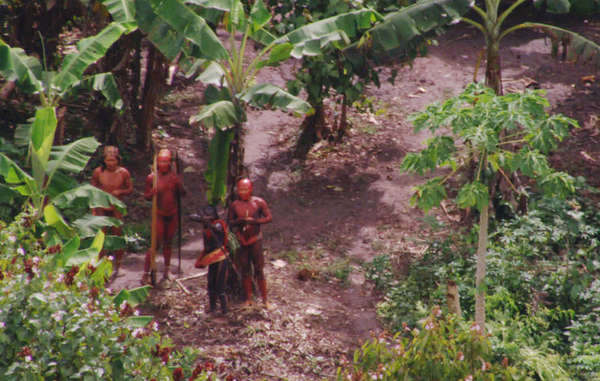
by Deep Green Resistance News Service | Sep 14, 2017 | Colonialism & Conquest, Mining & Drilling
Featured image: A still from aerial footage from 2011 of an uncontacted Amazon tribe in Brazil near the Peruvian border. © BBC/FUNAI/Survival
by Survival International
Brazilian Indians have appealed for global assistance to prevent further killings after the reported massacre of uncontacted tribespeople, and have denounced the government cuts that left their territories unprotected.
Paulo Marubo, a Marubo indigenous leader from western Brazil, said: “More attacks and killings are likely to happen. The cuts to FUNAI’s funding are harming the lives of indigenous people, especially uncontacted tribes, who are the most vulnerable.” (FUNAI is Brazil’s indigenous affairs agency).
Mr. Marubo is the leader of Univaja, an indigenous organization defending tribal rights in the Uncontacted Frontier, the area with the highest concentration of uncontacted tribes in the world.
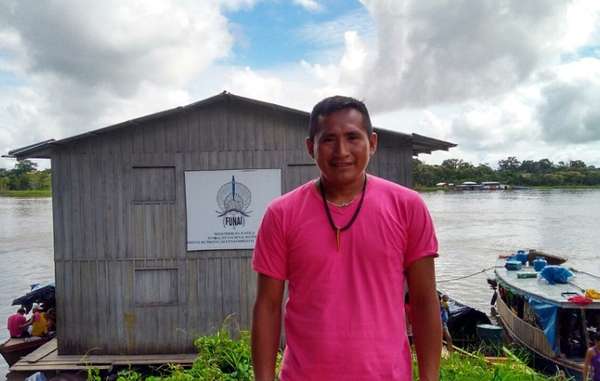
Paulo Marubo, leader of a Javari Valley indigenous organization from the Uncontacted Frontier. © Amazonas Atual
COIAB, the organization representing Indians across the Brazilian Amazon, denounced the massive cutbacks to FUNAI’s budget that has left many tribal territories unprotected:
“We vehemently condemn these brutal and violent attacks against these uncontacted Indians. This massacre shows just how much the rights of indigenous peoples in this country have been set back [in recent years].
“The cuts and dismantling of FUNAI are being carried out to further the interests of powerful politicians who want to continue ransacking our resources, and open up our territories for mining.”
Unconfirmed reports first emerged from the Amazon last week that up to 10 uncontacted tribal people had been killed by gold miners, and their bodies mutilated and dumped in a river.
The miners are reported to have bragged about the atrocity, whose victims included women and children, in a bar in a nearby town. The local prosecutor’s office has opened an investigation.
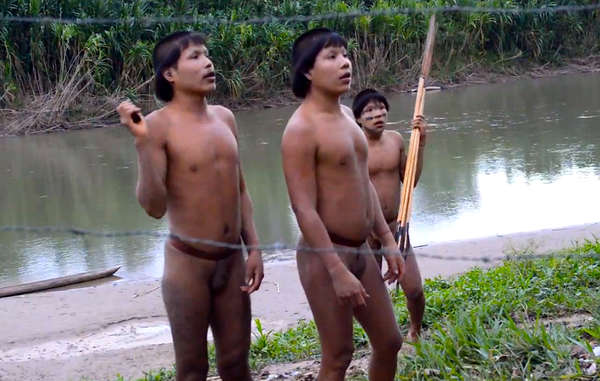
These Sapanawa Indians made contact in 2014. They reported their community had been attacked, and so many members of the village killed that they could not bury the dead. © FUNAI/Survival
The alleged massacre was just the latest in a long line of previous killings of isolated Indians in the Amazon, including the infamous Haximu massacre in 1993, in which 16 Yanomami Indians were killed by a group of gold miners.
More recently, a group of Sapanawa Indians emerged in the Uncontacted Frontier, reporting that their houses had been attacked and burnt to the ground by outsiders, who had killed so many members of the community that they had not been able to bury all the bodies.
All uncontacted tribal peoples face catastrophe unless their land is protected. Survival International is campaigning to secure their land for them, and to give them the chance to determine their own futures.
Survival’s Director Stephen Corry said: “The decision by the Brazilian government to slash funding for the teams that protect uncontacted Indians’ territories was not an innocent mistake. It was done to appease the powerful interests who want to open up indigenous lands to exploit – for mining, logging and ranching. These are the people the Indians are up against, and the deaths of uncontacted tribes won’t put them off. Only a global outcry can even the odds in the Indians’ favor, and prevent more such atrocities. We know public pressure works – many Survival campaigns have succeeded in the face of similar odds.”
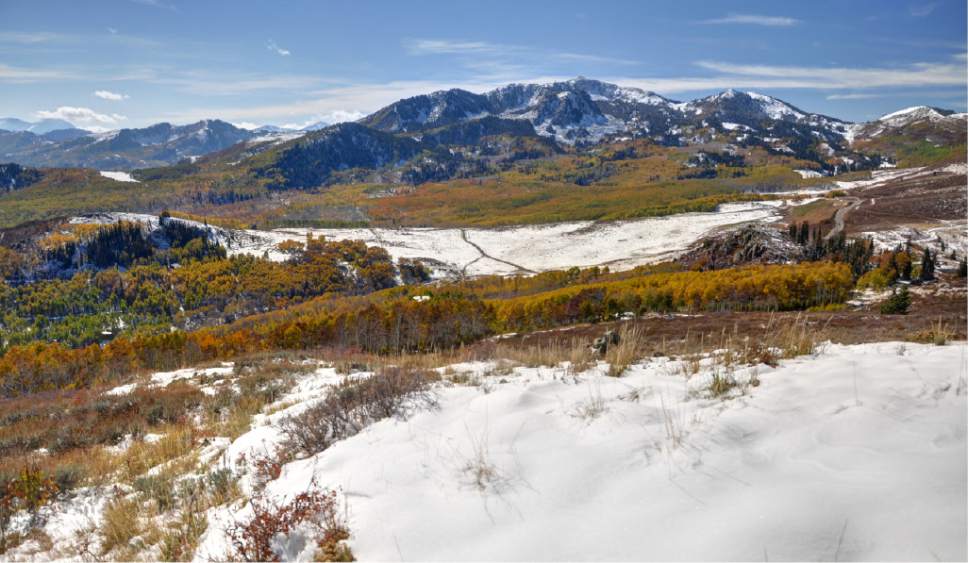
by Deep Green Resistance News Service | Sep 8, 2017 | Human Supremacy
Featured image: Bonanza Flats
Editor’s note: This is the second installment in a multi-part series. Browse the New Park City Witness index to read more.
by Will Falk / Deep Green Resistance
Before murdering millions during the Holocaust, the Nazis referred to Jews as rats. After murdering 17 people and lobotomizing some of his victims in an attempt to preserve them, alive but in a catatonic state, serial killer Jeffrey Dahmer explained, “…I tried to create living zombies…I just wanted to have the person under my complete control, not having to consider their wishes, being able to keep them there as long as I wanted.” In vivisection labs, scientists commonly cut animals’ vocal cords, so the scientists don’t have to listen to the animals scream.
These examples illustrate a common psychological phenomenon: In order to commit atrocities, humans characterize their victims as sub-human, objectify and silence them. It is, after all, much easier to destroy the less than human and the voiceless.
Civilized humans are currently destroying the natural world. Water continues to be polluted, air is poisoned, soil is lost faster than it can be replaced, and the collapse of every major biosphere across the planet intensifies. This destruction is made possible through the objectification and silencing of the natural world. The American legal system defines nature as property. Capitalism calls nonhumans “natural resources” and only values them as profits. The Abrahamic religions remove the sacred from the natural world and give it to an abstract, patriarchal God who somehow exists beyond the natural world.
It’s no wonder, then, that many in Park City participate in the silencing of nature, too. Many Parkites, for example, celebrate the existence of thousands of acres of land designated as “protected open space.”
There are several problems with this. First, the term “open space” is dishonest and works to objectify nonhumans while silencing the natural world. Objectification and silencing pave the way for exploitation. Second, as long as runaway climate change threatens snowfall, creates droughts, and contributes to wildfire intensity, no natural community in Park City can truly be considered “protected.” To call endangered natural communities protected leads to complacency, and we cannot afford complacency while the world burns.
The “Save Bonanza Flats” Campaign, which raised $38 million to protect 1,350 acres of high-altitude land from development, was a beautiful expression of the community’s love for life. Do not mistake me, I am deeply glad that Bonanza Flats is safe from hotels and multi-million dollar homes. But, Bonanza Flats is not safe, and will never be safe, as long as the dominant culture’s insatiable appetite for destruction is ensured by humans who believe the natural world is nothing more than lifeless matter for humans to use.
***
While working on this essay, I decided to head up Guardsman Pass to ask those who live in Bonanza Flats what they think about “protected open space.” Hiking is contemplative for me. I was asking myself just how, exactly, I thought the nonhumans in Bonanza Flats would express their feelings about being “open space” when I rounded a bend to find myself face to face with a bull and cow moose grazing among the aspen.
The aspen were mature, many of them boasting trunks eighteen and twenty-four inches in diameter. They grew closely together, creating an ancient silvan atmosphere with dappling silvers, golds, and greens. The afternoon sunshine mixed with aspen leaves to give me the slight, pleasant sense of existential vertigo that accompanies the timelessness of life’s original joys.
I met the bull moose’s gaze. My bones recognized their nearness to a greater collection of their kindred. My muscles, observing the moose’s, remembered their first purpose and tingled with excitement. His eyes, browns in brown, reflected all the different woods he’d ever strode through. I’m not sure how long we considered each other, but when he finally looked away, his wisdom was undeniable.
And, I had my first answer: To share an aspen grove with a bull moose in Bonanza Flats, is to know this space is anything but open.

I continued on to find a stone to sit on and watched the lazy orange flutter of butterfly wings. I listened to the soft hum of bees, the breeze through quaking aspen leaves, and the hypnotic click of grasshoppers in flight. I saw mule deer bounding over a fence, a red-tailed hawk riding wind pockets, and squirrels tossing pine cones to the ground, narrowly missing human heads (for the squirrels’ winter caches). All these beings confirmed the lesson the bull moose taught me. Bonanza Flats is not open, it is filled with countless living beings.
An approaching rain cloud brought tidings of the radical interconnectedness of all life and proved that Bonanza Flats is not truly protected. When the cloud arrived to give its water, the rain evaporated well before it reached us. I was reminded that Bonanza Flats, like all communities along the Wasatch Range, depend on snowpack for life-giving water. Simple arithmetic tells us that as long as total snowpack diminishes decade after decade, as it has been since the 1950s, sooner or later there won’t be enough water left.
While Bonanza Flats is safe from the developers’ bulldozers and chainsaws, many threats, just as deadly, still exist. Marssonina fungus spores, aided by climate change, could spread over aspen leaves until they no longer quake. Shorter winters allow the tiny pricks of too many tick bites to suck moose lives away. The worrisome scent of wildfire smoke haunts the wind. And, the asthmatic cough of children brought to the mountains by their parents to escape the Salt Lake Valley’s terrible air quality ring across Bonanza Flats’ trails.
***
Not all humans have objectified and silenced the natural world. For the vast majority of human history, humans lived in balance with the natural world we depend on. We lived in this way, in part, because we developed cultures that taught the sacredness of the natural world.
I’m writing this from the eastern edge of the Great Basin where the Western Shoshone, Paiute, Goshute, Washo and others lived sustainably for millennia. Much of my work in the region has been to protect pinyon-juniper forests from government-sponsored clearcuts. The forests make poor livestock grazing and ranchers make more money when the forests are replaced with grasses, so the forests are demonized. And, just like the demonization of Jews led to the Holocaust, the demonization of pinyon-juniper forests leads to millions of acres of clear-cuts.
Food from pinyon pine nuts and medicine from juniper trees were staples in many of the Great Basin’s traditional cultures. Pine nuts and juniper berries can be harvested without damaging the forests, so native peoples lived on what the land freely gave. In my research, I stumbled upon the transcript of a presentation[1] Glenn E. Wasson, a Western Shoshone man, gave at a pinyon-juniper conference hosted by the University of Nevada-Reno, the United States Forest Service, and the Bureau of Land Management. His words describe his people’s spirituality and represent a healthy relationship with the natural world.
Wasson said, “Each living entity constitutes a link in the chain of life. All those seen and unseen, all who grow from the ground, all those who crawl, all those who swim, all those who walk on legs, all those who fly, are all intertwined in the chain of life. Each plays a vital role in the keeping of a strong, healthy, and living Mother Earth, who provides each and every entity with all the necessities for life.” Contrast Wasson’s worldview with the dominant culture’s conception of nature as property, as resources, as objects and we begin to see why we’re in the mess we’re in.
While criticizing the Forest Service and BLM’s treatment of pinyon-juniper forests, Wasson described the mindset all of us must embrace. He said “…the cutting down of a single living tree is sacrilegious – the cutting down of a forest – UNTHINKABLE!” Until we begin to see individual nonhumans as sacred and natural communities worthy of our utmost respect, the destruction will continue.
Simply changing our language will not stop the destruction and I am not criticizing anyone’s efforts to protect Bonanza Flats from development. We need much more than better words and any land that stands free of development today, has a chance to stand free of development tomorrow. Land developed today may take decades to recover.
It’s not just Bonanza Flats. Park City boasts 8,000 acres of so-called protected open space. These are not protected open spaces. These are living natural communities where countless nonhumans live with lives as valuable to them as yours is to you. And, their lives are under attack.
I’m not writing anything you don’t already know. Most people in Park City are concerned about the natural world. Unfortunately, it appears that most Parkites are more interested in using the natural world, than in saving it. Why do I say this? Well, ask yourself, do most people in Park City spend more time confronting the forces destroying snow, or more time skiing on it? Do most people spend more time working to protect threatened Canada lynx, or more time mountain biking through Canada lynx’ homes? Do most people spend more time trying to save Colorado Pikeminnows, or more time flying fishing the waters Colorado Pikeminnows swim through?
There’s nothing wrong with enjoying the natural world. But, nonhumans do not exist for human enjoyment, they exist for themselves. It is only through centuries of cultural conditioning, teaching us to see the natural world as full of objects for our use, that some humans find nothing wrong with spending more time riding bikes than fighting for our nonhuman kin.
Life is created by complex collections of relationships formed by living creatures in natural communities. Water, air, soil, climate, and the food we eat depend on natural communities. The needs of these communities are primary; morality, the efforts of our daily lives, and our cultural teachings must emerge from a humble relationship with these natural communities. True sustainability is impossible without this.
Not long ago, all humans lived in humble relationships with natural communities. We developed traditional cultures that were rooted in the connectedness of all living beings. These cultures insisted upon the inherent worth of the natural communities who gave us life. Members of these cultures did not know “open spaces,” they knew places filled with those who grow from the ground, those who crawl, those who swim, those who walk on legs, and those who fly.
The dominance of a culture that objectifies and silences nature and calls natural communities “open space” enables its destruction. This culture has pushed the planet to the verge of total collapse. To avert collapse, the destruction must stop. We must create cultures where the exploitation of individual nonhumans is sacrilegious, and wholesale environmental destruction is unthinkable. We must stand in solidarity with all those – human and nonhuman – who share this living community we call Park City.
[1]Wassen, G.E. 1987. The American Indian response to the pinyon-juniper conference. In: Everett, R.L., comp. Proceedings: Pinyon-juniper conference. Gen. Tech. Rep. INT-GTR-215. Ogden, UT: U.S. Department of Agriculture, Forest Service, Intermountain Research Station: 38-41.
To repost this or other DGR original writings, please contact newsservice@deepgreenresistance.org
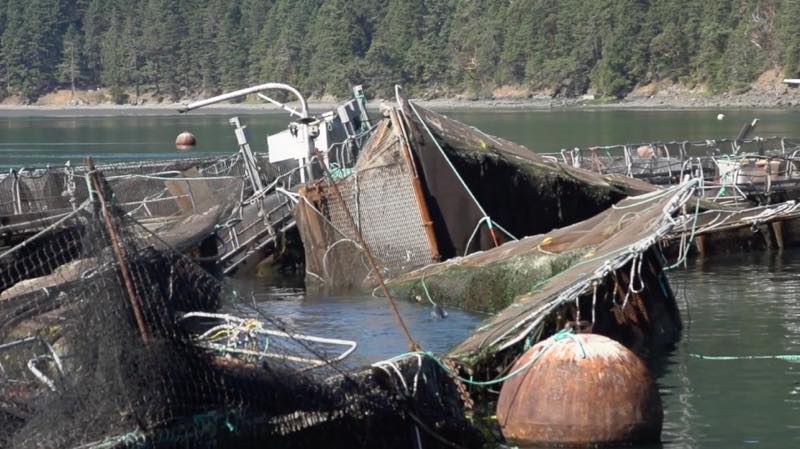
by Deep Green Resistance News Service | Aug 29, 2017 | Agriculture
Featured image: Still from video showing the broken pens of 300,000 Atlantic salmon that escaped from a fish farm off Cypress Island in Washington State. Vimeo/Wild Fish Conservancy
The Lummi Nation, the third largest tribe in Washington State, is in a state of emergency following the structural collapse of the Cooke Aquaculture open net-pen facility near Puget Sound. The breach released more than 300,000 farmed Atlantic salmon into Pacific waters, adjacent to Cypress Island, just east of the Canadian border near Victoria B.C.
State officials announced over the weekend that no new permits would be issued for fish farm operations until the cause of the incident was determined. Lummi Nation Fisheries have been catching thousands of Atlantic salmon alongside wild Pacific salmon for several days, but officials still believe many of the invasive fish are already on their way to spawn in local streams and rivers. Tribal fishermen have hauled in at least 200,000 pounds of invasive Atlantic salmon since the emergency declaration, the Lummi said on Monday August 28.
“This disaster could have devastating effects and could potentially decimate this year’s run of Chinook salmon,” said Lummi Natural Resources Director Merle Jefferson. “This is unacceptable for all residents of the Puget Sound. We are doing what we can to help limit the damage, but as far as we know, containment is indefinite. These invasive fish are going to find our rivers.”
Kurt Beardslee, director of the Wild Fish Conservancy Northwest (WFCN) called the incident an environmental disaster and is preparing to file a civil suit against Cooke Aquaculture under section 505 of the Clean Water Act.
“This dangerous and reckless industry not only threatens the recovery of our native salmon and orca populations but also threatens the health of Puget Sound and the Northwest’s cultural identity,” Beardslee said in a WFCN press release.
Following the failure of the net-pen that contained 305,000 Atlantic salmon, Cooke Aquaculture cited the “exceptionally high tides” caused by the August 21 solar eclipse as the reason for the breech at its facility. In a statement, Cooke Aquaculture said its Cypress Farm #2, which contained the Atlantic salmon, had been in operation for almost 30 years without incident. In addition the company cited its “solid track record” in modern marine farming at several locations across the globe, including facilities in Maine, Scotland, Spain and Chile.
“It is estimated that several thousand Atlantic salmon escaped following a structural failure of part of the net-pen structure on the Cypress Site 2 farm,” Cooke Aquaculture said in the statement. “It appears that many fish are still contained within the nets. It will not be possible to confirm exact numbers of fish losses until harvesting is completed and an inventory of fish in the pens has been conducted.”
However, tides were almost a foot higher last January than on the evening of the solar eclipse, NPR reported. This left Beardslee “bewildered by the company’s claim that the solar eclipse presented a tidal occurrence that they could not have prepared for,” he said.
Emergency maintenance was performed on the Cypress Island net-pens on July 27, which further calls into question the company’s claim that high tides during the solar eclipse were the cause of the facility’s structural failure. Washington State officials released a guide to help fishermen identify the Atlantic salmon and how to contain them if caught. In addition, Governor Jay Inslee put a hold on new net-pen permits “until a thorough investigation of this incident is completed,” he said in a statement.
“Tribes and others who fish Washington waters deserve a comprehensive response to this incident, including answers to what happened and assurances that it won’t happen again,” Inslee said. “I believe the company must do everything it can to stop any additional escapes and to recover as many fish as possible, including adequate compensation for those working to remove Atlantic salmon from our waters.”
The Quinault Indian Nation said this was a good start, but did not do enough to recognize the threat posed by farmed Atlantic salmon, which is being done with profit rather than health in mind.
“We have been objecting to the open-water farming of Atlantic salmon for years,” said Quinault Nation President Fawn Sharp in a statement. “The disaster near Cypress Island seems to have finally generated a strong response from the state. We’re glad about that. But we want the state and the public to know it’s a serious problem here, too.”
North of the U.S.–Canada border, environmental groups in British Columbia are sounding the alarm once again over the farming of non-native Atlantic salmon in Pacific waters, which could potentially devastate an area that still sees some of the largest wild Pacific salmon runs in the world. Watershed Watch Salmon Society, an environmental organization based out of Coquitlam B.C., called the incident “an epic disaster.” They’re asking anglers to be on the lookout for Atlantic salmon in streams and rivers on the southern edge of Vancouver Island and have renewed calls to end the use of fish farms on the Pacific Coast.
Canada’s federal Department of Fisheries and Ocean (DFO) said the Liberal government is taking the case very seriously and is closely monitoring the situation.
“We will be working to understand the potential impacts of this incident and prevent any damage to Canada’s marine ecosystems, said Minister of Fisheries, Oceans and the Canadian Coast Guard, Dominic LeBlanc in a statement. “DFO is communicating with its U.S. counterparts, the National Oceanic and Atmospheric Administration and other U.S. regulators to help ensure impacts from the incident are minimized.”
The recently formed British Columbia New Democratic Party (NDP) government said in an e-mail it was aware of the situation and would be working closely with DFO. So far no Atlantic salmon have been recovered in Canadian waters. However, government officials are asking B.C. residents to report any and all Atlantic salmon caught in Canadian waters through its Atlantic Salmon Watch Program.
British Columbians have been debating the risk of fish farms for decades. Due to conservation efforts and lobbying in the early 2000s, no fish farms are currently operating along B.C.’s North Coast. However, the Cooke Aquaculture breech is renewing calls to shut down all fish farms along the province’s south coast, which have long been opposed by local First Nations.
Over the years First Nations along the south coast of Vancouver Island have repeatedly called for an end to open net-pen fish farms, claiming they breed diseased, unnatural salmon that can transmit viruses to wild populations and hinder First Nations’ ability to operate food fisheries. Union of B.C. Indian Chiefs Vice President Bob Chamberlin said First Nations have a legal right to practice their traditional ways to gather sustenance from the land, including wild salmon.
“If the government of B.C. and Canada continue to ignore the impacts of open net-pen aquaculture on wild salmon, then we are looking to an imminent future without the constitutionally protected wild salmon food source critical to First Nations in B.C., and without a once proud economic driver that our wild salmon fisheries provide to indigenous and non-Indigenous communities alike,” he said.
Following the release to the Aboriginal Peoples Television Network (APTN) of video showing deformed and diseased Atlantic salmon in open net-pens operated by Grieg Seafood, Hereditary Chief Ernest Alfred of the Nagmis, Lawit’sis and Mamalilikala Nations began occupying a facility near Swanson Island near Vancouver Island, planning to stay until the operation is shut down indefinitely.
“This place is ours, and we’re not moving,” Alfred wrote in a Facebook post. “We must stop open-net fish farms in our waters. It’s time to stand up and take a stand.”
The issue undermines attempts at reconciliation between Indigenous Peoples and the Canadian government, Alfred continued.
“You can’t ignore the issue of rights and title, which are clearly being violated here,” said Alfred. “You have politicians traveling the country talking about reconciliation. How can we have reconciliation when we have this disease running through our territory?”
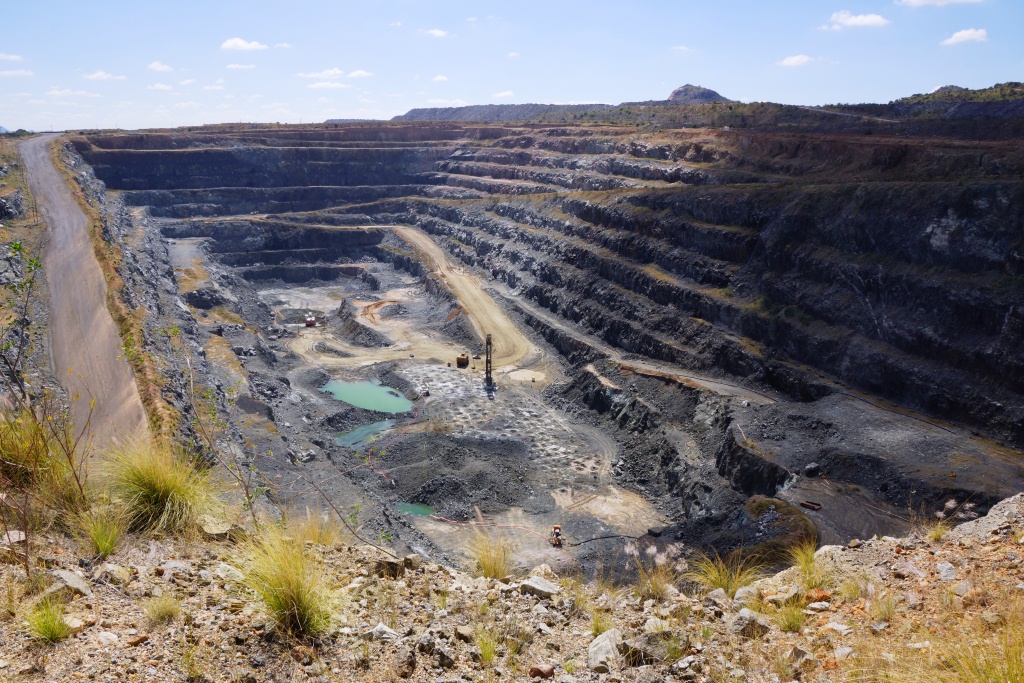
by Deep Green Resistance News Service | Aug 28, 2017 | Toxification
Peak oil extraction has passed and extraction will decline from this point onward. No industrial renewables are adequate substitutes. Richard C. Duncan sums it up in his “Olduvai Theory” of industrial civilization. Duncan predicted a gradual per capita energy decline between 1979 and 1999 (the “slope”) followed by a “slide” of energy production that “begins in 2000 with the escalating warfare in the Middle East” and that “marks the all-time peak of world oil production.” After that is the “cliff,” which “begins in 2012 when an epidemic of permanent blackouts spreads worldwide, i.e., first there are waves of brownouts and temporary blackouts, then finally the electric power networks themselves expire.”34 According to Duncan, 2030 marks the end of industrial civilization and a return to “global equilibrium”—namely, the Stone Age.
Natural gas is also near peak production. Other fossil fuels, such as tar sands and coal, are harder to access and offer a poor energy return. The ecological effects of extracting and processing those fuels (let alone the effects of burning them) would be disastrous even compared to petroleum’s abysmal record.
Will peak oil avert global warming? Probably not. It’s true that cheap oil has no adequate industrial substitute. However, the large use of coal predates petroleum. Even postcollapse, it’s possible that large amounts of coal, tar sands, and other dirty fossil fuels could be used.
Although peak oil is a crisis, its effects are mostly beneficial: reduced burning of fossil fuels, reduced production of garbage, and decreased consumption of disposable goods, reduced capacity for superpowers to project their power globally, a shift toward organic food growing methods, a necessity for stronger communities, and so on. The worst effects of peak oil will be secondary—caused not by peak oil, but by the response of those in power.
Suffering a shortage of fossil fuels? Start turning food into fuel or cutting down forests to digest them into synthetic petroleum. Economic collapse causing people to default on their mortgages? Fuel too expensive to run some machines? The capitalists will find a way to kill two birds with one stone and institute a system of debtors prisons that will double as forced labor camps. A large number of prisons in the US and around the world already make extensive use of barely paid prison laborers, after all. Mass slavery, gulags, and the like are common in preindustrial civilizations. You get the idea.
Featured image: Mogolokwena Platinum Mine, South Africa
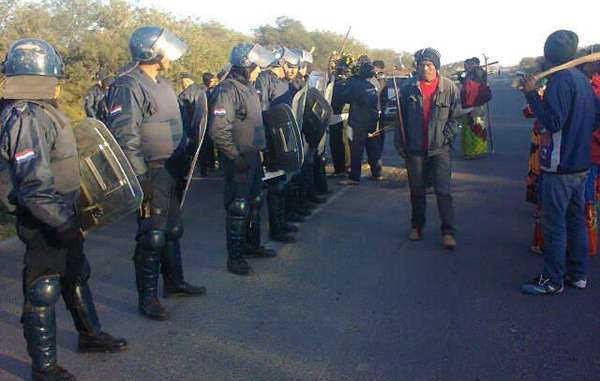
by Deep Green Resistance News Service | Aug 24, 2017 | Biodiversity & Habitat Destruction
Featured image: There have been confrontations between the Ayoreo and the Paraguayan authorities in recent years, as the tribe have protested against the theft and destruction of their land.© GAT/ Survival
by Survival International
Landmark talks between the Paraguayan government and a recently contacted tribe have yet to reach an agreement, allowing rampant deforestation to continue. Some members of the tribe are uncontacted, and live in a rapidly shrinking island of forest.
The talks began six months ago after a petition from the Ayoreo tribe to the Inter-American Commission on Human Rights, an influential body which holds governments in the Americas to account on human rights issues. The Ayoreo have been claiming the right to their ancestral land since 1993.
Halfway through the year-long process, however, and little concrete action has been taken, leading to fears for the tribe’s long-term survival. A technical study is due to be carried out to assess the feasibility of securing the land.
The government has also failed to stop the rapid logging of land owned by the Ayoreo, despite a 2016 emergency order from the Inter-American Commission to protect the uncontacted Indians and halt deforestation.
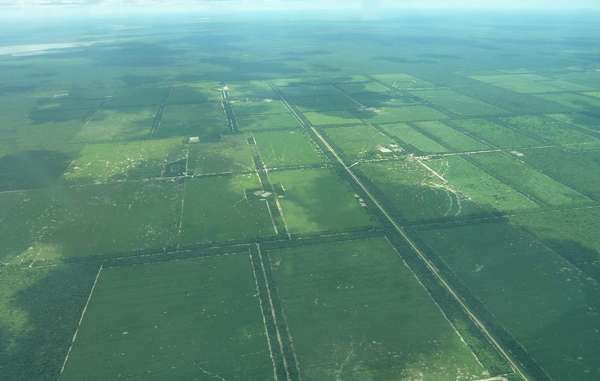
Aerial photograph showing the devastation that logging has brought to Ayoreo land. © Survival
Background briefing
– The Ayoreo live in the Chaco, which is the largest forest in South America outside the Amazon and has recently been recorded as having the highest rate of deforestation in the world. Experts estimate that the forest lost almost 10 million trees in January 2017.
– This poses a deadly threat to the Ayoreo, who face catastrophe unless their land is protected.
– Many members of the Ayoreo tribe were forcibly contacted by missionaries between 1969 and 1986. Continual land invasions forced them to abandon their homes. Many have since suffered from disease, including a TB-like illness, poverty, and exploitation on the fringes of mainstream Paraguayan society.
– Recently contacted members of the tribe spent years fleeing from bulldozers, which they called “beasts with metal skin.” The machines are used by loggers to clear paths for cutting trees.
– The petition which finally brought the Paraguayan government to the negotiating table is called Petition 850-15. It features a claim for the restitution of Ayoreo land.
– In February 2016, the Inter-American Commission issued an emergency order (MC 54-13) calling for the protection of uncontacted Ayoreo and their forests. Although this was in response to a separate petition submitted by the Ayoreo, the orders are to also be discussed during the talks.
– The local support group GAT, and indigenous organization OPIT, have played an important role in lobbying the government, and after months of warning, finally pressed them to investigate the logging in July 2017. It remains to be seen whether the deforestation will be stopped and the perpetrators brought to justice.
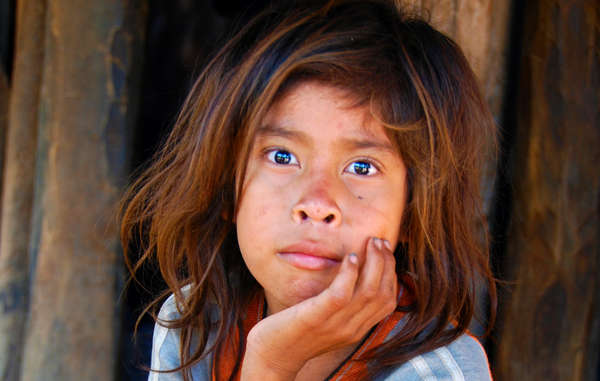
Most of the Ayoreo have been forced out of the forest. They have since been fighting for their land rights. © Survival
Survival International is calling for a complete halt to logging on Ayoreo land, and for the return of all lands which have been titled to ranching companies.
Uncontacted tribes are not backward and primitive relics of a remote past. They are our contemporaries and a vitally important part of humankind’s diversity. Where their rights are respected, they continue to thrive.
They are the best guardians of their environment. And evidence proves that tribal territories are the best barrier to deforestation.
Survival’s Director Stephen Corry said: “The Ayoreo have already been waiting more than twenty years for their lands to be protected. All this time they’ve seen their forests destroyed about them. They hoped the Inter-American Commission’s intervention would finally push the government to act, but that hope too has proved an illusion. Tragically, it seems that Paraguay’s government is so firmly tied to the ranchers and landowners who control the levers of power that nothing short of massive public pressure will move them to act.”











